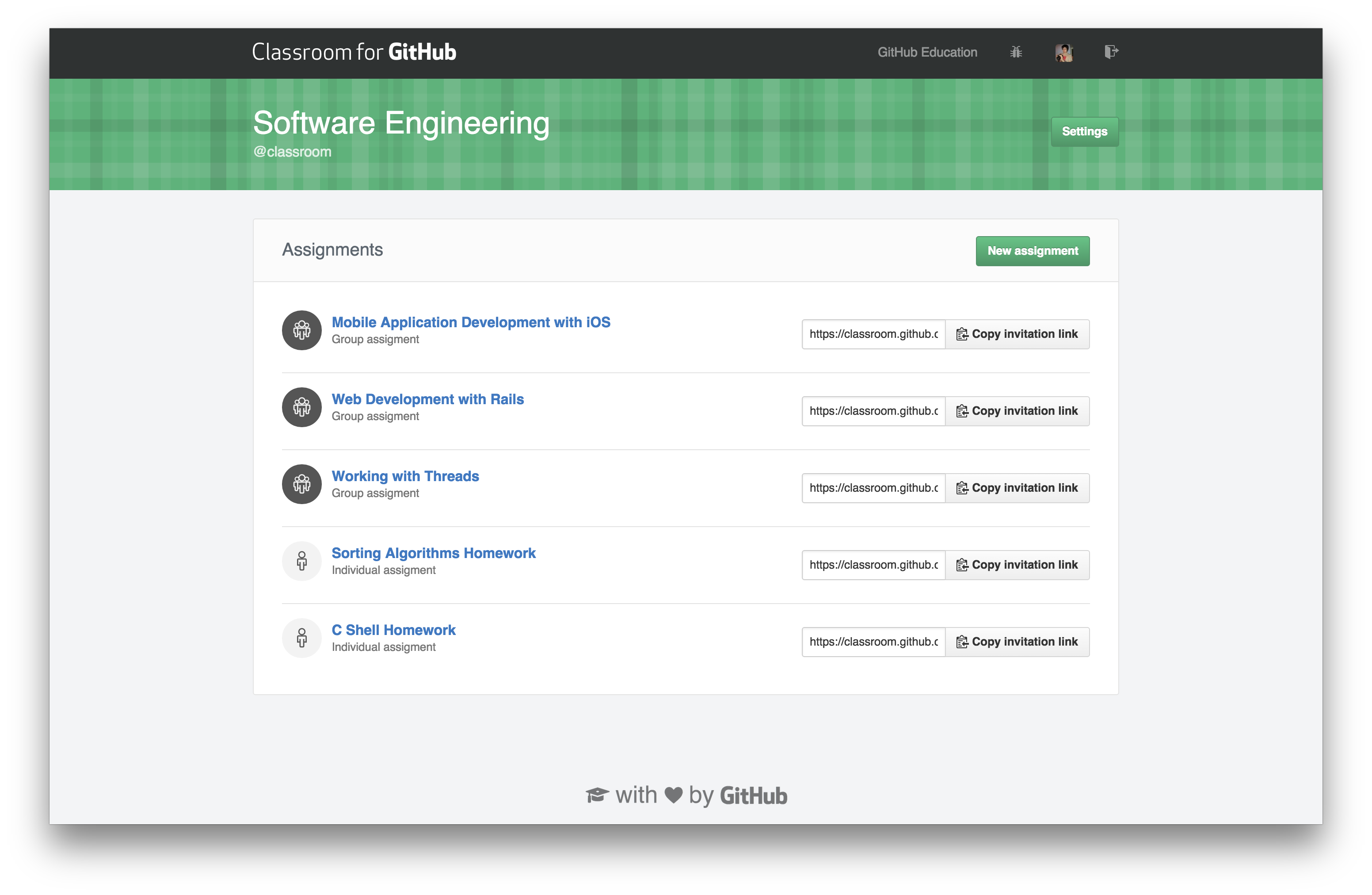Classroom for GitHub
Classroom for GitHub is a Ruby on Rails application designed to automate repository creation and access control, making it easy for teachers to distribute starter code and collect assignments on GitHub
How it works
Assignments are the core of Classroom for GitHub. Teachers can easily create an assignment and distribute it to students using a private invitation URL. Optional starter code can be provided for individual or group work. It's even possible to delegate assignment creation and management to co-teachers and teaching assistants by adding them as organization administrators.
Hacking on Classroom for GitHub
Get started
New to Ruby? No worries! You can follow these instructions to install a local server.
Installing a Local Server
First things first, you'll need to install Ruby 2.3.0. We recommend using the excellent rbenv, and ruby-build
rbenv install 2.3.0
rbenv global 2.3.0Next, you'll need to make sure that you have Nodejs, PostgreSQL, Redis, Memcached, and Elasticsearch installed. This can be done easily :
- For OSX using Homebrew : You don't have to do anything! When you run
script/setuplater on this will be taken care of for you. - For Linux :
apt-get install nodejs postgresql redis-server memcached. For Elasticsearch, follow the instructions on their website.
You will want to set PostgreSQL to autostart at login via launchctl, if not already. See brew info postgresql. Redis and memcached may be setup similarly via launchctl or setup project wide by using foreman, described below.
Now, let's install the gems from the Gemfile ("Gems" are synonymous with libraries in other
languages).
gem install bundler && rbenv rehashSetup Classroom for GitHub
If you are using Linux, configure PostgreSQL :
- Edit
/etc/postgresql/9.3/main/postgresql.confand uncomment#unix_socket_permissions = 0777 - Create a user and give him the rights to create a database :
su postgres -s /bin/bash -c "psql -c 'CREATE USER classroom_user; ALTER USER classroom_user CREATEDB'"(Changeclassroom_userto the username that will run the classroom server)
Once bundler is installed (and PostgreSQL correctly configured for Linux users) go ahead and run the setup script :
script/setup
Production environment variables
| ENV Variable | Description |
|---|---|
AIRBRAKE_ID |
the ID for application in airbrake.io, if set Airbrake will be enabled |
AIRBRAKE_PROJECT_KEY |
the PROJECT_KEY in airbrake.io, if set Airbrake will be enabled |
CANONICAL_HOST |
the preferred hostname for the application, if set requests served on other hostnames will be redirected |
GOOGLE_ANALYTICS_TRACKING_ID |
identifier for Google Analytics in the format UA-.* |
PINGLISH_ENABLED |
Enable the /_ping endpoint with relevant health checks |
MOTD |
Show the message of the day banner at the top of the site |
Development environment variables
These values must be present in your .env file (created by script/setup).
| ENV Variable | Description |
|---|---|
GITHUB_CLIENT_ID |
the GitHub Application Client ID. |
GITHUB_CLIENT_SECRET |
the GitHub Application Client Secret. |
NON_STAFF_GITHUB_ADMIN_IDS |
GitHub user_ids of users to be granted staff level access. |
To obtain your GitHub Client ID/Secret you need to register a new OAuth application.
After you register your OAuth application, you should fill in the homepage url with http://localhost:5000 and the authorization url with http://localhost:5000/auth/github/callback.
To obtain your GitHub User ID for the NON_STAFF_GITHUB_ADMIN_IDS field, go to https://api.github.com/users/your_username
Testing environment variables
If you want to make a functionality change to the application you will need to write tests to accompany that change. In order to do this, the test values in the .env file must be filled in.
Classroom for GitHub uses VCR for recording and playing back API fixtures during test runs. These cassettes (fixtures) are part of the Git project in the spec/support/cassettes folder. If you're not recording new cassettes you can run the specs with existing cassettes with:
script/testClassroom for GitHub uses environmental variables for storing credentials used in testing, these values are located in your .env file (created by script/setup).
If you are recording new cassettes, you need to make sure all of these values are present.
| ENV Variable | Description |
|---|---|
TEST_CLASSROOM_OWNER_GITHUB_ID |
The GitHub user_id of an organization admin. |
TEST_CLASSROOM_OWNER_GITHUB_TOKEN |
The Personal Access Token for the classroom owner |
TEST_CLASSROOM_STUDENT_GITHUB_ID |
Test OAuth application client ID. |
TEST_CLASSROOM_STUDENT_GITHUB_TOKEN |
The Personal Access Token for the student |
TEST_CLASSROOM_OWNER_ORGANIZATION_GITHUB_ID |
GitHub ID (preferably one created specifically for testing against). |
TEST_CLASSROOM_OWNER_ORGANIZATION_GITHUB_LOGIN |
GitHub login (preferably one created specifically for testing against). |
To obtain these values you will need:
- A teacher (your primary GitHub account)
- A student (another Github account, created for this purpose)
- An organisation that the teacher is an owner of, but the student does not belong to.
It is best if you create your own organization for testing purposes, if you have done so:
To obtain the OWNER_GITHUB_ID value, you can go to https://api.github.com/users/organization_owner_username.
To obtain the OWNER_GITHUB_TOKEN value, you will need to generate a personal access token.
To get the STUDENT_GITHUB_ID value you will need to create another user account on GitHub and get the ID by going to https://api.github.com/users/student_username
To get the STUDENT_GITHUB_TOKEN value you will need to generate another personal access token for the student account.
To obtain the OWNER_ORGANIZATION_GITHUB_ID/LOGIN you can go to https://api.github.com/orgs/organization_name.
Now you should have all of the values filled in, great job!
Running the application
Foreman is setup to manage redis, memcached, sidekiq, and elasticsearch in development mode. Postgresql must be running prior executing foreman.
After that, you may start the rails server in a separate terminal with:
script/serverAnd that's it! You should have a working instance of Classroom for GitHub located here
Deployment
We strongly encourage you to use https://classroom.github.com, but if you would like your own version Classroom for GitHub can be easily deployed to Heroku.
Contributing
We'd love to have you participate. Please check out contributing guidelines.
Contributors
Classroom is developed by these contributors.
Shout out to GitHub Summer of Code student, Mark Tareshawty, from The Ohio State University for his work on Classroom for GitHub.
